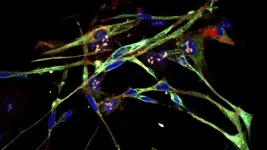(Press-News.org) Fat is a normal and necessary part of the body. Fat cells store and release energy, as well as play significant roles in hormonal regulation and immunity.
In recent decades, a concerning rise in metabolic illnesses – such as cardiovascular disease, high blood pressure and diabetes – has focused scientific attention on the biology and chemistry of fat, resulting in a wealth of information about how fat cells work.
But fat cells and their metabolic activities are only part of the story.
Fat-filled lipid droplets, tiny spheres of fat many times smaller than fat cells, are a growing subject of scientific interest. Found inside many different cell types, these lipid particles have long been little understood. Studies have begun to illuminate these droplets’ participation in metabolic functions and cellular protection, but we still know next to nothing about the physical nature of fat.
Now, researchers at the University of Pennsylvania School of Engineering and Applied Science have looked beyond biochemistry to publish groundbreaking work on the physics of these droplets, revealing them to be a potential threat to a cell’s nucleus. In the August issue of the Journal of Cell Biology, they are the first to discover fat-filled lipid droplets’ surprising capability to indent and puncture the nucleus, the organelle which contains and regulates a cell’s DNA.
The stakes of their findings are high: a ruptured nucleus can lead to elevated DNA damage that is characteristic of many diseases, including cancer.
The study was led by Dennis E. Discher, Robert D. Bent Professor in the Department of Chemical and Biomolecular Engineering, Irena Ivanovska, Ph.D. Research Associate in Penn’s Molecular and Cell Biophysics Lab, and Michael Tobin, Ph.D. Candidate in the Department of Bioengineering.
“Intuitively, people think of fat as soft,” says Discher. “And on a cellular level it is. But at this small size of droplet— measuring just a few microns rather than the hundreds of microns of a mature fat cell—it stops being soft. Its shape has a much higher curvature, bending other objects very sharply. This changes its physics in the cell. It can deform. It can damage. It can rupture.”
“Imagine,” adds Ivanovska, “trying to pop a balloon with your fist. Impossible. You can deform the balloon, but you won’t puncture it. Now imagine trying to pop it with a pen. That’s the difference between a fat cell and a cell with small fat droplets in the body. It’s a fundamental physical difference, not a metabolic one.”
The team’s research reframes scientific inquiry into fat, underlining that fat’s role in the body is much more than just a number on the scales.
“This isn’t fat canonically conceived,” says Tobin. “This is about how fat works at scales smaller than a cell and poses physical risks to cellular components, even at the level of DNA.”
The team’s work builds on a decade of foundational research, including leading contributions by Ivanovska, into the behaviors of nuclear proteins that give the nucleus its protective structural qualities. These proteins are dynamic, shifting levels to respond to their mechanical environments and provide what the nucleus needs to maintain its integrity.
“There’s a constant process of repair to DNA damage that goes on in cells,” says Ivanovska. “For this to happen, the nucleus needs to have enough DNA repair proteins. If a nucleus is ruptured, these proteins scatter and cannot repair damage in a timely manner. This causes DNA damage accumulation and can potentially result in a cancer cell.”
A cell lives in a dynamic physical and mechanical environment where things can and do go wrong. But it also has an army of molecular helpers always working to maintain and repair it.
“The problem is,” says Discher, “when a nucleus is compromised – by toxins, overexposure to UV rays, or these fat-filled lipid droplets. Then there is a strong potential for DNA damage and that comes with consequences for health.”
END
The physics of fat droplets reveal DNA danger
2023-08-28
ELSE PRESS RELEASES FROM THIS DATE:
SfN’s TPDA Program earns ASAE 2023 Power of Associations Gold Award
2023-08-28
WASHINGTON, D.C. – The Society for Neuroscience (SfN) earned a Power of Associations Gold Award from the American Society of Association Executives (ASAE) for its successful Trainee Professional Development Award (TPDA) program. ASAE’s Power of Association awards celebrate and promote the invaluable contributions that associations make within the U.S. and globally through catalytic initiatives focused on professional advancement, global development, diversity and inclusion practices, advocacy, and community support and engagement.
In operation since 2015, the TPDA program recognizes undergraduate and graduate ...
New approach to fighting malaria
2023-08-28
RIVERSIDE, Calif. -- The mosquito-borne infectious disease malaria resulted in about 241 million clinical episodes and 627,000 deaths in 2020. In young children and pregnant women living in areas where the disease is endemic, a major cause of death is Plasmodium falciparum, the most virulent, prevalent, and deadly human malaria parasite.
Scientists are keen to understand the mechanisms that regulate gene expression through the different stages of P. falciparum’s lifecycle because such knowledge can ...
UMass Amherst computer scientists use AI to accelerate computing speed by thousands of times
2023-08-28
AMHERST, Mass. – A team of computer scientists at the University of Massachusetts Amherst, led by Emery Berger, recently unveiled a prize-winning Python profiler called Scalene. Programs written with Python are notoriously slow—up to 60,000 times slower than code written in other programming languages—and Scalene works to efficiently identify exactly where Python is lagging, allowing programmers to troubleshoot and streamline their code for higher performance.
There are many different programming ...
Rare disease shares mechanism with cystic fibrosis
2023-08-28
Aug. 28, 2023
Images
ANN ARBOR—University of Michigan researchers have discovered that the same cellular mechanism involved in a form of cystic fibrosis is also implicated in a form of a rare disease called cystinosis.
The mechanism cleans up mutated proteins. In cystinosis, a genetic disease, this allows cystine crystals to build up in the cell. This disrupts the cell, and eventually, tissues and ultimately organs, particularly the kidneys and the eyes.
The problem begins when the lysosome, an organelle within the cell, is unable to ...
Once rhabdomyosarcoma, now muscle
2023-08-28
“Every successful medicine has its origin story. And research like this is the soil from which new drugs are born,” says Cold Spring Harbor Laboratory Professor Christopher Vakoc.
For six years, Vakoc’s lab has been on a mission to transform sarcoma cells into regularly functioning tissue cells. Sarcomas are cancers that form in connective tissues like muscle. Treatment often involves chemotherapy, surgery, and radiation—procedures that are especially tough on kids. If doctors could transform cancer cells into healthy cells, it would offer patients a whole new treatment option—one that could spare them and their families a great deal of ...
Past abrupt changes in North Atlantic Overturning have impacted the climate system across the globe
2023-08-28
The Dansgaard-Oeschger events are rapid Northern-Hemisphere temperature jumps of up to 15°C in Greenland that repeatedly occurred within a few decades during the last ice age. “These events are the archetype of abrupt climate changes and further increasing our understanding of them is crucial for more reliable assessments of the risk and possible impacts of future large-scale climate tipping events”, says Niklas Boers from the Potsdam Institute for Climate Impact Research (PIK) and the Technical University of Munich, one of the authors of the study to be published in the Proceedings of the National Academy of Sciences PNAS.
In the ...
Historic red tide event of 2020 fueled by plankton super swimmers
2023-08-28
A major red tide event occurred in waters off Southern California in the spring of 2020, resulting in dazzling displays of bioluminescence along the coast. The spectacle was caused by exceedingly high densities of Lingulodinium polyedra (L. polyedra), a plankton species renowned for its ability to emit a neon blue glow. While the red tide captured the public’s attention and made global headlines, the event was also a harmful algal bloom. Toxins were detected at the height of the bloom that had the potential to harm marine life, and dissolved oxygen levels dropped to near-zero as the extreme biomass of the red tide decomposed. This lack of oxygen led to fish die-offs ...
Intravascular imaging associated with improved outcomes compared with angiography
2023-08-28
Amsterdam, Netherlands – 27 Aug 2023: Intravascular imaging-guided percutaneous coronary intervention (PCI) is associated with a lower rate of target lesion failure compared with angiography-guided PCI, according to late breaking research presented in a Hot Line session today at ESC Congress 2023.1
Numerous randomised trials have compared intravascular imaging-guided PCI with angiography-guided PCI. However, most of these prior trials have used intravascular ultrasound (IVUS). Optical coherence ...
Pulsed field ablation is noninferior to thermal ablation in paroxysmal atrial fibrillation
2023-08-28
Amsterdam, Netherlands – 27 Aug 2023: Pulsed field ablation (PFA) is as effective and safe as conventional thermal ablation for the treatment of paroxysmal atrial fibrillation (AF), according to late breaking research presented in a Hot Line session today at ESC Congress 2023.1
ESC guidelines recommend catheter ablation after failure of drug therapy in patients with paroxysmal AF.2 Conventional ablation technology uses thermal energy (either heat/radiofrequency energy or cold/cryothermal energy) to ablate the tissue. Unlike thermal ablation, PFA uses high energy electrical pulses to destroy tissue by a process called electroporation. Preclinical ...
Mazin to study ab initio engineering of doped-covalent-bond superconductors
2023-08-28
Mazin To Study Ab Initio Engineering Of Doped-Covalent-Bond Superconductors
Igor Mazin, Professor of Practice for Advanced Studies in Theoretical Physics, Quantum Materials Center, Physics and Astronomy, is set to receive funding for the project: "Collaborative research: Ab Initio Engineering of Doped-Covalent-Bond Superconductors."
This EAGER award will support a joint computational and theoretical effort to guide the search for practical superconducting materials.
Superconductors carry electrical current without any resistance when cooled down below a certain material-dependent ...



